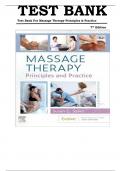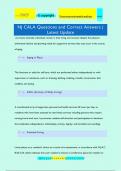TEST BANK
Test Bank For Massage Therapy-Principles & Practice
TE
7th Edition
S
TB
A N
KS
O
LU
TI
O
N
S
, Susan G. Salvo: Massage Therapy- Principles and Practice
Chapter 01: History of Massage: Prehistoric Times to the Modern Era and Professional
Societies, Organizations, and Associations.
TE
MULTIPLE CHOICE
1. Which method is defined as manipulation of soft tissue using pressure and traction for
clinical, therapeutic, and palliative purposes?
S
a. Acupuncture
b. Ayurveda
c. Polarity therapy
TB
d. Massage therapy
ANS: D
Massage therapy the manipulation of soft tissue using compression and
decompression/traction for clinical, therapeutic, and palliative purposes or for wellness and
A
self-care purposes.
2. Which origin for the word massage is Greek?
N
a. Mashesh
b. Masso
c. Masser
KS
d. Makeh
ANS: B
The origin of the word massage is unclear, but can be traced to numerous sources: the Hebrew
mashesh, the Greek masso and massin, the Latin massa, the Arabic mass’h, the Sanskrit
makeh, and the French masser.
O
3. When was the earliest the term massage was used by most European-based cultures?
a. 1600s
LU
b. 1700s
c. 1800s
d. 1900s
ANS: C
By the early 1800s, the term massage was used by most European-based cultures.
TI
Historically, massage was referred to by its techniques such as friction or rubbing.
4. The first written records of massage date back to 3000 BCE in which country?
a. India
O
b. China
c. Egypt
d. Greece
N
ANS: B
Written records regarding the practice of massage go back to 3000 BCE in China.
S
Acupuncture was not mentioned in Chinese writings until 90 BCE.
5. Which work is commonly referred to as the classic scripture of traditional Chinese medicine?
, a. Tao Te Ching
b. Nei Ching
c. Ayur-Veda
d. Corpus Hippocraticum
ANS: B
TE
At the time of Hwang Ti, various ideas and beliefs were compiled under the name of the
Yellow Emperor (died in 2599 BCE) which became the classic scripture of traditional Chinese
medicine known as the Nei Chang. The Nei Chang was written about 2760 BCE, and this
work contains detailed descriptions of massage procedures as well as herbal medicines.
S
6. What is the original massage technique in China and the precursor to manual and energetic
therapies?
a. Polarity
TB
b. Shiatsu
c. Acupuncture
d. Amma
ANS: D
A
Amma is regarded as the original massage technique and precursor to all other Chinese
therapies, manual and energetic.
N
7. Which healing method is based on Hindu tradition?
a. Ayurveda
b. Shiatsu
KS
c. Amma
d. Polarity
ANS: A
Knowledge of amma massage traveled to the subcontinent of India from China, and massage
became part of Hindu tradition. Massage is described in India’s first great medical texts, the
O
Ayurveda books of wisdom (about 1800 BCE) and recommend massage as an indispensable
healing procedure.
8. Which method is Japanese but based on Chinese medicine concepts, and uses pressure applied
LU
from the practitioner’s thumbs, elbows, and other parts of the body?
a. Ayurveda
b. Shiatsu
c. Massage
d. Amma
TI
ANS: B
Shiatsu is a Japanese method based on the same traditional Chinese medicine concepts as
acupuncture —energy flows in the body through streams called channels or meridians.
O
Acupuncturists use needles at specific points to balance the flow of energy; shiatsu
practitioners use their fingers, thumbs, forearms, elbows, and even their knees and feet.
N
9. Who is generally recognized as the father of modern Western medicine?
a. Galen
b. Celsus
S
c. Rhazes
, d. Hippocrates
ANS: D
Hippocrates was known to be a fine physician, founder of a medical school, author of
numerous books, and advocated the use of massage or “rubbing.” These works are
collectively known as the Corpus Hippocraticum, and summarized much of what was known
TE
about disease and medicine in the ancient world. Hippocrates is generally recognized as the
father of modern Western medicine, and he believed that physicians should avoid causing
harm to patients.
10. Who wrote the Canon of Medicine, the most famous book in the history of medicine in both
S
the East and the West?
a. Rhazes
b. Celsus
TB
c. Avicenna
d. Hippocrates
ANS: C
A text entitled or Canon of Medicine was written by one of the greatest
A
Persian physicians of his era, Avicenna (980-1037). He was also known as Ibn Sina. The
Canon of Medicine is the most famous book in the history of medicine in both the East and
the West.
N
11. Which individual discussed the effects of massage and used friction on joints in the 1500s?
a. Paré
KS
b. Harvey
c. Galen
d. Mezger
ANS: A
Ambroise Paré (1515-1590) was a famous French surgeon who was among the earliest
O
individuals in this era to discuss the effects of massage. He used friction to treat dislocated
joints and other orthopedic conditions.
12. Who was the first known scientist to demonstrate that blood circulation due to muscular
LU
contraction of the heart?
a. Paré
b. Galen
c. Harvey
d. Mezger
TI
ANS: C
English scientist William Harvey (1578–1657) discovered the circulation of blood in 1628,
and his writings did much to promote the acceptance of massage as a treatment measure.
O
Harvey observed the hearts of living animals and determined that active phase of the heart
muscular contraction (systole) pumped blood through arteries and veins.
N
13. Who developed the Swedish Movement Cure, which included the use of massage?
a. Johann Mezger
b. Pehr H. Ling
S
c. George Henry Taylor





